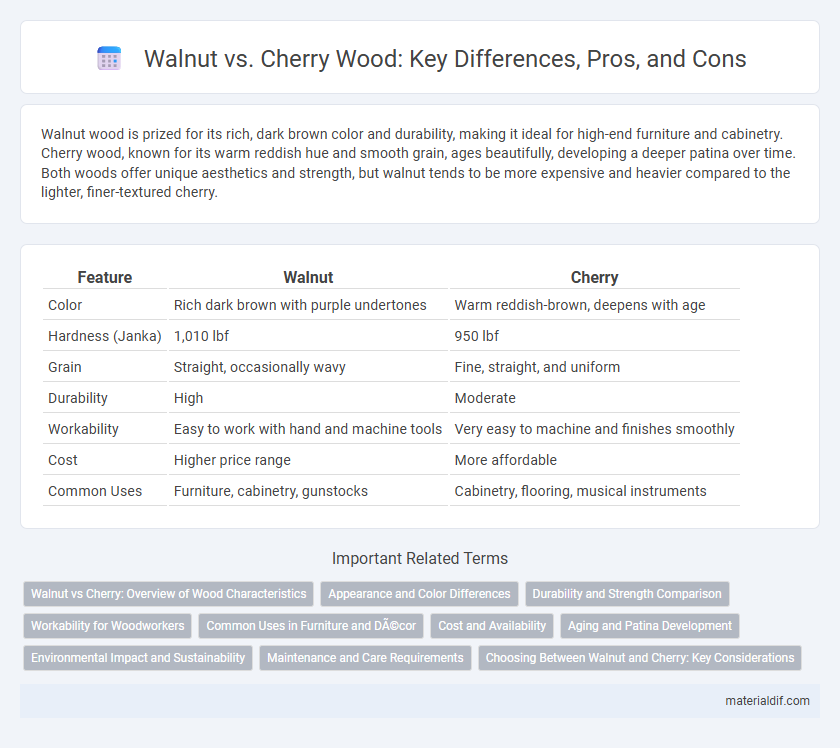Walnut wood is prized for its rich, dark brown color and durability, making it ideal for high-end furniture and cabinetry. Cherry wood, known for its warm reddish hue and smooth grain, ages beautifully, developing a deeper patina over time. Both woods offer unique aesthetics and strength, but walnut tends to be more expensive and heavier compared to the lighter, finer-textured cherry.
Table of Comparison
| Feature | Walnut | Cherry |
|---|---|---|
| Color | Rich dark brown with purple undertones | Warm reddish-brown, deepens with age |
| Hardness (Janka) | 1,010 lbf | 950 lbf |
| Grain | Straight, occasionally wavy | Fine, straight, and uniform |
| Durability | High | Moderate |
| Workability | Easy to work with hand and machine tools | Very easy to machine and finishes smoothly |
| Cost | Higher price range | More affordable |
| Common Uses | Furniture, cabinetry, gunstocks | Cabinetry, flooring, musical instruments |
Walnut vs Cherry: Overview of Wood Characteristics
Walnut wood exhibits a rich, dark brown color with pronounced grain patterns, offering durability and resistance to wear, making it ideal for high-end furniture and cabinetry. Cherry wood features a warm reddish-brown hue that deepens with age, known for its smooth texture and moderate hardness, well-suited for elegant cabinetry and fine woodworking. Both woods provide excellent workability, but walnut tends to be more stable and less prone to warping compared to cherry.
Appearance and Color Differences
Walnut wood features a rich, dark brown hue with deep chocolate and purplish undertones, often accompanied by striking grain patterns that range from straight to wavy. Cherry wood is known for its warm, reddish-brown color that darkens to a rich patina over time with exposure to light, exhibiting a smooth, fine grain texture. The contrast between walnut's cooler, darker tones and cherry's warmer, lighter shades makes each choice distinct for furniture and cabinetry applications.
Durability and Strength Comparison
Walnut wood offers medium strength and hardness, making it durable for furniture, but it is softer than cherry, which ranks higher on the Janka hardness scale. Cherry wood provides excellent strength and durability, often preferred for high-traffic areas and heavy-use furnishings due to its resistance to dents and wear. Both woods develop a beautiful patina over time, but cherry's superior hardness ensures longer-lasting performance in demanding applications.
Workability for Woodworkers
Walnut wood is prized for its excellent workability, offering smooth cutting, planing, and sanding with minimal tool wear, making it ideal for detailed woodworking projects. Cherry wood, although slightly harder than walnut, carves well and finishes beautifully, gaining a smooth, rich patina over time that enhances its appeal. Both woods respond well to hand and machine tools, but walnut's fine grain and consistent texture give it a slight edge for intricate joinery and carving tasks.
Common Uses in Furniture and Décor
Walnut is highly prized for its rich, dark color and durability, making it ideal for high-end furniture like dining tables, cabinetry, and intricate woodwork in decor. Cherry wood, known for its warm reddish tones that deepen with age, is commonly used in traditional and contemporary furniture pieces, including dressers, chairs, and paneling. Both woods offer distinct aesthetic qualities, with walnut favored for luxury and lasting strength, while cherry is preferred for its smooth grain and elegant, inviting appearance.
Cost and Availability
Walnut wood commands a higher price due to its rich color, durability, and limited supply, making it less readily available than Cherry. Cherry wood is generally more affordable and easier to source, thanks to its faster growth rate and widespread availability in North America. Both woods remain popular choices, but budget-conscious buyers often lean toward Cherry for cost-effectiveness and consistent availability.
Aging and Patina Development
Walnut develops a rich, deep patina over time, darkening with exposure to light and enhancing its natural grain for a warm, elegant finish. Cherry wood exhibits a smooth aging process, gradually shifting from a pale pinkish tone to a rich reddish-brown, creating a distinctive, lustrous patina. Both woods age beautifully, with walnut offering a more dramatic darkening effect and cherry presenting a subtle, warm maturation.
Environmental Impact and Sustainability
Walnut wood, harvested mainly from slow-growing trees in North America and Europe, has a moderate environmental impact due to longer growth cycles and selective logging practices that support sustainable forestry. Cherry wood, sourced predominantly from fast-growing trees in the eastern United States, often benefits from managed forests promoting quicker regeneration and reduced carbon footprint. Both woods' sustainability depends heavily on certification standards like FSC, with cherry wood generally favored for lower impact due to its faster replenishment rates.
Maintenance and Care Requirements
Walnut wood requires occasional conditioning with oil to maintain its rich, dark color and prevent drying or cracking, while cherry wood develops a natural patina over time that benefits from gentle cleaning and periodic polishing to preserve its warm reddish hue. Both woods should be protected from excessive moisture and direct sunlight to avoid warping and fading. Proper maintenance ensures durability and enhances the aesthetic appeal of walnut and cherry furniture.
Choosing Between Walnut and Cherry: Key Considerations
Walnut offers a rich, dark brown color with intricate grain patterns, making it ideal for statement furniture and high-end cabinetry, while cherry wood provides a warm reddish hue that deepens with age, popular for its smooth texture and fine grain. Consider walnut for projects requiring durability and a luxurious appearance, as it is harder and more resistant to dents than cherry, which is softer and easier to work with but may show scratches more readily. Budget and project timeline also influence choice; walnut tends to be more expensive and has a longer curing time, whereas cherry is generally more affordable and readily available.
Walnut vs Cherry Infographic

 materialdif.com
materialdif.com